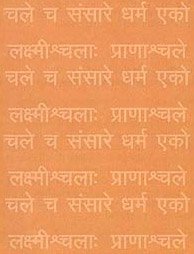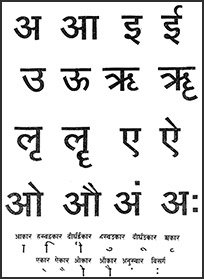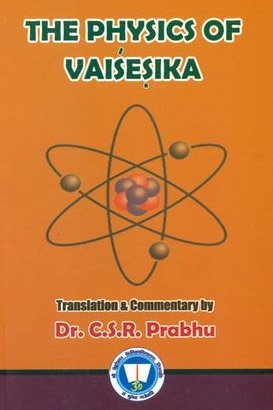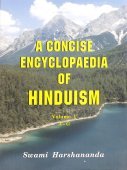Anitya: 27 definitions
Introduction:
Anitya means something in Buddhism, Pali, Hinduism, Sanskrit, Jainism, Prakrit, Marathi, Hindi. If you want to know the exact meaning, history, etymology or English translation of this term then check out the descriptions on this page. Add your comment or reference to a book if you want to contribute to this summary article.
Alternative spellings of this word include Anity.
In Hinduism
Samkhya (school of philosophy)
Source: Shodhganga: Prakrti and purusa in Samkhyakarika an analytical reviewAnitya (अनित्य, “non-eternal”).—Generally, that which is not eternal is called anitya. Ordinarily anitya means vināśi. That which is able to be annihilated is called vināśi. So, vināśa means complete destruction, which brings in unending non-existence of the thing destroyed (dhvaṃsābhāva).

Samkhya (सांख्य, Sāṃkhya) is a dualistic school of Hindu philosophy (astika) and is closeley related to the Yoga school. Samkhya philosophy accepts three pramanas (‘proofs’) only as valid means of gaining knowledge. Another important concept is their theory of evolution, revolving around prakriti (matter) and purusha (consciousness).
Vyakarana (Sanskrit grammar)
Source: Wikisource: A dictionary of Sanskrit grammarAnitya (अनित्य).—(l) not nitya or obligatory optional; said of a rule or paribhāṣā whose application is voluntary). Regarding the case and con= jugational affixes it can be said that those affixes can, in a way: be looked upon as nitya or obligatory, as they have to be affixed to a crude nominal base or a root; there being a dictum that no crude base without an affix can be used as also, no affix alone without a base can be used. On the other hand, the taddhita and kṛt affixes as also compounds are voluntary as, instead of them an independent word or a phrase can be used to convey the sense. For a list of such nitya affixes see M. Bh. on V. 4.7; (2) the word अनित्य (anitya) is also used in the sense of not-nitya, the word नित्य (nitya) being taken to mean कृताकृतप्रसङ्गि (kṛtākṛtaprasaṅgi) occurring before as well as after another rule has been applied, the latter being looked upon as अनित्य (anitya) which does not do so. This 'nityatva' has got a number of exceptions and limitations which are mentioned in Paribhāṣās 43-49 in the Paribhāṣenduśekhara.

Vyakarana (व्याकरण, vyākaraṇa) refers to Sanskrit grammar and represents one of the six additional sciences (vedanga) to be studied along with the Vedas. Vyakarana concerns itself with the rules of Sanskrit grammar and linguistic analysis in order to establish the correct context of words and sentences.
Vaisheshika (school of philosophy)
Source: Shodhganga: A study of Nyāya-vaiśeṣika categories (vaisesika)Anitya (अनित्य, “non-eternal”) or Nityaguṇa refers to a classification of the twenty-four guṇas (qualities).—Guṇas are again divided into nitya (eternal) and anitya (non-eternal). The qualities of eternal substances are known as eternal qualities and the qualities of noneternal substances are known as non-eternal qualities. Eternal substances are the atoms of earth etc., ether, time, space, self and mind.

Vaisheshika (वैशेषिक, vaiśeṣika) refers to a school of orthodox Hindu philosophy (astika), drawing its subject-matter from the Upanishads. Vaisheshika deals with subjects such as logic, epistemology, philosophy and expounds concepts similar to Buddhism in nature
Ayurveda (science of life)
Source: gurumukhi.ru: Ayurveda glossary of termsAnitya (अनित्य):—Non eternal or Transient.

Āyurveda (आयुर्वेद, ayurveda) is a branch of Indian science dealing with medicine, herbalism, taxology, anatomy, surgery, alchemy and related topics. Traditional practice of Āyurveda in ancient India dates back to at least the first millenium BC. Literature is commonly written in Sanskrit using various poetic metres.
Shaktism (Shakta philosophy)
Source: Google Books: ManthanabhairavatantramAnitya (अनित्य) or Anityājñāna refers to “impermanent (ignorance)”, according to the Kularatnapañcakāvatāra verse 1.16-23ab.—Accordingly, “One who suffers knows (reality) in the midst of suffering because (of his) impermanent ignorance (anitya-ajñāna-svabhāvata). O fair lady, (the consequences of) Karma must be experienced due to the (power) of Karma and that is inevitable. Having understood this there is no attachment or (even) detachment in pleasure and pain. One who knows the condition of his own consciousness does not become subject to Karma. Nor should one take up any other means on the supreme plane that consists of (pure) consciousness. Thus, O goddess, this is said to be the supreme Kulakaula. [...]”.

Shakta (शाक्त, śākta) or Shaktism (śāktism) represents a tradition of Hinduism where the Goddess (Devi) is revered and worshipped. Shakta literature includes a range of scriptures, including various Agamas and Tantras, although its roots may be traced back to the Vedas.
Purana and Itihasa (epic history)
Source: archive.org: Shiva Purana - English TranslationAnitya (अनित्य) refers to “those who are non-eternal”, according to the Śivapurāṇa 2.3.29 (“Śivā-Śiva dialogue”).—Accordingly, as Śiva said to Pārvatī: “O great Goddess, listen to my important statement. See that our marriage rites are performed in the proper manner without deficiency. O sweet-faced one, all the living beings Brahmā and others are non-eternal (anitya). O beautiful lady, know all these visible things to be perishable. Know that the single beings assumed manifold forms. The attributeless took over the attributes. That which is self-luminous had other lights imposed on it. [...]”.

The Purana (पुराण, purāṇas) refers to Sanskrit literature preserving ancient India’s vast cultural history, including historical legends, religious ceremonies, various arts and sciences. The eighteen mahapuranas total over 400,000 shlokas (metrical couplets) and date to at least several centuries BCE.
In Buddhism
Mahayana (major branch of Buddhism)
Source: Wisdom Library: Maha Prajnaparamita SastraAnitya (अनित्य, “impermanence”) refers to one of the eight kinds of contemplations (anupaśyanā) among the Buddha’s disciples, according to the 2nd century Mahāprajñāpāramitāśāstra (chapter XVI). Accordingly, “for them, everything is impermanent (anitya), suffering (duḥkha), empty (śūnya), egoless (anātmaka), like a sickness (roga), an ulcer (gaṇḍa), like an arrow (śalya) stuck in one’s body, like an agony (agha)”.
Source: academia.edu: A Study and Translation of the GaganagañjaparipṛcchāAnitya (अनित्य) refers to “(that which is) not eternal”, according to the Gaganagañjaparipṛcchā: the eighth chapter of the Mahāsaṃnipāta (a collection of Mahāyāna Buddhist Sūtras).—Accordingly, “[...] The Bodhisattva Gaganagañja then sustained the jewel-canopy of ten thousand yojanas high over the Lord’s lion throne in the sky, joined the palms of his hands, saluted, and praised the Lord with these suitable verses: ‘[...] (3) You never make though-constructions (nirvikalpa) connected to words or sentences. Having known the essential character of sentence cannot be grasped because it is like an echo, also having known [the essential character of] words and letters (akṣara) cannot be grasped because they are not eternal (anitya), O Friendly One, you promulgate the teachings of the Victorious One by great compassion. [...]”.

Mahayana (महायान, mahāyāna) is a major branch of Buddhism focusing on the path of a Bodhisattva (spiritual aspirants/ enlightened beings). Extant literature is vast and primarely composed in the Sanskrit language. There are many sūtras of which some of the earliest are the various Prajñāpāramitā sūtras.
Buddhist philosophy
Source: Google Books: The Treasury of Knowledge: Book six, parts one and two (philosophy)Anitya (अनित्य) (Sanskrit; in Tibetan: mi rtag pa) refers to “impermanent objects”, representing one of the six types of “objects” (viṣaya) (i.e., ‘that which is to be comprehended or known’).—Accordingly, “That which is to be understood through valid cognition is ‘the knowable’. The terms ‘object’ (viṣaya; yul), ‘knowable’ (jñeya; shes bya), and ‘appraisable’ (prameya; gzhal bya) are all essentially equivalent, but it is the defining characteristic of the ‘object’ that it is to be comprehended or known, [...]. When objects (viṣaya) are analyzed in terms of their essential nature, they may be: [i.e., “impermanent objects” (anitya; mi rtag pa) do not endure from the moment of their formation into a second moment;] [...]
-
In Jainism
Jain philosophy
Source: archive.org: Anekanta Jaya Pataka of Haribhadra SuriAnitya (अनित्य) refers to one of the twelve reflections (bhāvanā), as mentioned in the Anekāntajayapatākā-prakaraṇa, a Śvetāmbara Jain philosophical work written by Haribhadra Sūri.—[Cf. Vol. II, P. 223, ll. 22-25]—Anitya-bhāvanā refers to the reflection that—Everything is transitory. Various paraphernalia, relatives, physical strength, beauty etc. are all subject to change. Only the soul is eternal.
-
General definition (in Jainism)
Source: The University of Sydney: A study of the Twelve Reflections1) Anitya (अनित्य) (Cf. Anityatā) refers to “impermanence”, according to the Jain Yogaśāstra (vol. 2, p. 839).—Accordingly, “Equanimity is attained through the state of non-attachment. In order to attain that [state of non-attachment], one should cultivate the twelve themes of contemplation: on impermanence (anityatā), helplessness, the cycle of transmigration, solitude, the distinction [of the Self and the body], the impurity [of the body], the influx of karmic matter, the stopping [of karmic influx], the elimination of karmic matter, the correctly expounded law, the universe, and the [difficulty of attaining] enlightenment”.
2) Anitya (अनित्य) (Prakrit: Aṇicca) also refers to “(reflection on) impermanence” and represents one of the four types of “virtuous meditation” (dharmadhyāna), a classification of the “meditation” (Dhyāna), according to the Sthānāṅga Sūtra chapter 4.1.—The classification of meditation in the Sthānāṅga Sūtra comprises four kinds [e.g. “virtuous” (dhamma/dharma)]. [...] The four reflections that are prescribed for virtuous meditation are (dhammajhāṇa), [e.g., reflection on impermanence (aṇicca-aṇuppehā/anitya-anuprekṣā), ...].—Cf Aupapātika Sūtra and Bhagavatī (Bhagavaī), also known as the Vyākhyāprajñapti (Viyāhapannatti).
Source: academia.edu: Tessitori Collection IAnitya (अनित्य) refers to “(reflection on the) transient” and represents one of the twelve Bhāvanās (topics for meditation), according to a manuscript [Bāra bhāvanā] (dealing with the Ethics section of Jain Canonical literature) included in the collection of manuscripts at the ‘Vincenzo Joppi’ library, collected by Luigi Pio Tessitori during his visit to Rajasthan between 1914 and 1919.—There are traditionally 12 bhāvanās or topics for meditation (also known as anuprekṣā, see Tattvārthasūtra 9.7 as locus classicus). In the present manuscript [Bāra bhāvanā], only the first six are dealt with, each in a few stanzas, followed by a section-title: [e.g.,] 1. reflection on the transient (anitya, 4 stanzas, ends on 49v9). [...]

Jainism is an Indian religion of Dharma whose doctrine revolves around harmlessness (ahimsa) towards every living being. The two major branches (Digambara and Svetambara) of Jainism stimulate self-control (or, shramana, ‘self-reliance’) and spiritual development through a path of peace for the soul to progess to the ultimate goal.
Languages of India and abroad
Marathi-English dictionary
Source: DDSA: The Molesworth Marathi and English Dictionaryanitya (अनित्य).—a (S) Not enduring always; transitory, fugitive, fleeting. Ex. a0 prapañca jō anātmā. 2 Occasional, incidental.
Source: DDSA: The Aryabhusan school dictionary, Marathi-Englishanitya (अनित्य).—a Not eternal, perishable, tran- sient. Unsteady. Uncertain.
Marathi is an Indo-European language having over 70 million native speakers people in (predominantly) Maharashtra India. Marathi, like many other Indo-Aryan languages, evolved from early forms of Prakrit, which itself is a subset of Sanskrit, one of the most ancient languages of the world.
Sanskrit dictionary
Source: DDSA: The practical Sanskrit-English dictionaryAnitya (अनित्य).—a.
1) Not eternal or everlasting, transient, non-eternal, perishable (naśvara) (opp. nitya); गन्धवती पृथ्वी सा द्विविधा नित्याऽनित्या च (gandhavatī pṛthvī sā dvividhā nityā'nityā ca) T. S.9 (anityā = kāryarūpā); See नित्य (nitya); यदि नित्यमनित्येन निर्मलं मलवाहिना । यशः कायेन लभ्येत तन्न लब्धं भवेन्तु किम् (yadi nityamanityena nirmalaṃ malavāhinā | yaśaḥ kāyena labhyeta tanna labdhaṃ bhaventu kim) || H.1.45. रजस्वलमनित्यं च भूतावासमिमं त्यजेत् (rajasvalamanityaṃ ca bhūtāvāsamimaṃ tyajet) Manusmṛti 6.77; धर्मोऽनित्यः सुखदुःखेऽप्यनित्ये जीवोऽनित्यो हेतुरस्या- प्यनित्यः (dharmo'nityaḥ sukhaduḥkhe'pyanitye jīvo'nityo heturasyā- pyanityaḥ) Mb.
2) Occasional, temporary, casual; not peremptory or obligatory as a rule &c., special.
3) Unusual, extraordinary; वर्णे चानित्ये (varṇe cānitye) P.V.4.31 (lohitakaḥ kopena, anyathā tu śvetavarṇa iti bhāvaḥ); आनाय्योऽनित्ये (ānāyyo'nitye) III.1.127 (sa hi gārhapatyādānīyate'nityaśca satatamaprajvalanāt Sk.) See VI.1. 147.
4) Unsteady, fickle, not permanent; अनित्यं यौवनं रूपम् (anityaṃ yauvanaṃ rūpam) H.4.68; °हृदया हि ताः (hṛdayā hi tāḥ) Rām.
5) Uncertain, doubtful; अनित्यो विजयो यस्माद् दृश्यते युध्यमानयोः (anityo vijayo yasmād dṛśyate yudhyamānayoḥ) Manusmṛti 7.199; विजयस्य ह्यनित्यत्वात् (vijayasya hyanityatvāt) Pañcatantra (Bombay) 3.22.
6) (in grammar) A rule or operation which is not invariable or compulsory; optional.
-tyam adv. Occasionally, not permanently, incidentally, casually; अनित्यं हि स्थितो यस्मात् (anityaṃ hi sthito yasmāt) Manusmṛti 3.12.
Source: Cologne Digital Sanskrit Dictionaries: Shabda-Sagara Sanskrit-English DictionaryAnitya (अनित्य).—mfn.
(-tyaḥ-tyā-tyaṃ) 1. Transient, not everlasting. 2. Occasional, incidental. 3. Irregular, unusual. E. a neg. nitya constant.
Source: Cologne Digital Sanskrit Dictionaries: Benfey Sanskrit-English DictionaryAnitya (अनित्य).—adj. 1. perishable, 6, 77. 2. occasional, 7, 199. 3. inconstant. [Rāmāyaṇa] 2, 4, 26; uncertain, 5, 29, 31. 4. ºyam, adv. not perpetually, [Mānavadharmaśāstra] 3, 102. Ātmanitya, i. e.
Anitya is a Sanskrit compound consisting of the terms a and nitya (नित्य).
Source: Cologne Digital Sanskrit Dictionaries: Cappeller Sanskrit-English DictionaryAnitya (अनित्य).—[adjective] not everlasting, perishable, transient, inconstant; [abstract] tā [feminine], tva [neuter]
Source: Cologne Digital Sanskrit Dictionaries: Monier-Williams Sanskrit-English Dictionary1) Anitya (अनित्य):—[=a-nitya] mfn. not everlasting, transient, occasional, incidental
2) [v.s. ...] irregular, unusual
3) [v.s. ...] unstable
4) [v.s. ...] uncertain
Source: Cologne Digital Sanskrit Dictionaries: Goldstücker Sanskrit-English DictionaryAnitya (अनित्य):—[tatpurusha compound] m. f. n.
(-tyaḥ-tyā-tyam) 1) Transient, not ever-lasting (as the body, or in the Sāṅkhya philosophy the discrete principles mahat, ahaṅkāra &c. or in the Nyāya the sound &c.
2) Occasional, not peremptory, not obligatory as a rule &c. (see also kāmya; as in the Jyotiṣṭoma the six saṃsthās: atyagniṣṭoma, ukthya, ṣoḍaśin, atirātra, aptoryāma and vājapeya &c.).
3) Not necessary, not immutable. See anityasamāsa.
4) Unstable, inconstant.
5) Unusual, irregular. (anityam not always.) E. a neg. and nitya.
Source: Cologne Digital Sanskrit Dictionaries: Yates Sanskrit-English DictionaryAnitya (अनित्य):—[a-nitya] (tyaḥ-tyā-tyaṃ) a. Transient; occasional, irregular.
Source: DDSA: Paia-sadda-mahannavo; a comprehensive Prakrit Hindi dictionary (S)Anitya (अनित्य) in the Sanskrit language is related to the Prakrit words: Aṇicca, Aṇiya.
[Sanskrit to German]
Sanskrit, also spelled संस्कृतम् (saṃskṛtam), is an ancient language of India commonly seen as the grandmother of the Indo-European language family (even English!). Closely allied with Prakrit and Pali, Sanskrit is more exhaustive in both grammar and terms and has the most extensive collection of literature in the world, greatly surpassing its sister-languages Greek and Latin.
Hindi dictionary
Source: DDSA: A practical Hindi-English dictionaryAnitya (अनित्य) [Also spelled anity]:—(a) transient, transitory; variable; fleeting; hence~[tā] (nf).
...
Kannada-English dictionary
Source: Alar: Kannada-English corpusAnitya (ಅನಿತ್ಯ):—[adjective] not lasting; not permanent; temporary; impermanent.
Kannada is a Dravidian language (as opposed to the Indo-European language family) mainly spoken in the southwestern region of India.
See also (Relevant definitions)
Starts with (+2): Anityabhava, Anityabhavana, Anityadatrima, Anityadatta, Anityadattaka, Anityaguna, Anityajnana, Anityakarman, Anityakriya, Anityalakshana, Anityam, Anityanupreksha, Anityapratyaveksha, Anityasama, Anityasamaprakarana, Anityasamasa, Anityasamjna, Anityata, Anityatadrishti, Anityatanupreksha.
Ends with: Adananitya, Aranyanitya, Arthanitya, Atmanitya, Dharmanitya, Dhyananitya, Kulanitya, Nityanitya, Pranitya, Shastranitya, Vananitya.
Full-text (+87): Anityam, Anityasama, Anityakriya, Anityata, Anityabhava, Anityakarman, Anityapratyaveksha, Anityadatrima, Aniya, Anityadatta, Anicca, Anityatva, Nityanitya, Anityadattaka, Anityasamasa, Anityasamaprakarana, Nittiyanittiyam, Anatman, Anity, Paratma.
Relevant text
Search found 56 books and stories containing Anitya, A-nitya; (plurals include: Anityas, nityas). You can also click to the full overview containing English textual excerpts. Below are direct links for the most relevant articles:
Maha Prajnaparamita Sastra (by Gelongma Karma Migme Chödrön)
IV. Links between impermanence, suffering and non-self < [Chapter XXXVII - The Ten Concepts]
II. Synonymity of the three words < [Part 2 - Understanding dharmatā and its synonyms]
Part 3 - Patience in regard to the Buddhadharma < [Chapter XXV - Patience Toward the Dharma]
Vaisheshika-sutra with Commentary (by Nandalal Sinha)
Sūtra 4.1.4 (The eternal exists) < [Chapter 1 - Of Atoms]
Sūtra 1.1.8 (Resemblances of Substance, Attribute, and Action) < [Chapter 1 - Of Substance, Attribute, and Action]
Sūtra 2.2.32 (Above continued) < [Chapter 2 - Of the Five Bhūtas, Time, and Space]
Shrimad Bhagavad-gita (by Narayana Gosvami)
Verse 9.33 < [Chapter 9 - Rāja-guhya-yoga (Yoga through the most Confidential Knowledge)]
Puranic encyclopaedia (by Vettam Mani)
Nyaya-Vaisheshika categories (Study) (by Diptimani Goswami)
Qualities (6): Parimāṇa (Dimension) < [Chapter 4 - Quality and Action]
Qualities (7): Pṛthaktva (Distinctness) < [Chapter 4 - Quality and Action]
Qualities (14): Sneha (Viscidity) < [Chapter 4 - Quality and Action]
Chaitanya Bhagavata (by Bhumipati Dāsa)
Verse 2.1.342 < [Chapter 1 - The Beginning of the Lord’s Manifestation and His Instructions on Kṛṣṇa-saṅkīrtana]
Verse 1.12.89 < [Chapter 12 - The Lord’s Wandering Throughout Navadvīpa]
Verse 1.7.124 < [Chapter 7 - Śrī Viśvarūpa Takes Sannyāsa]
Related products
